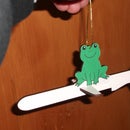Introduction: Make a SmartPhone Into Something Useful
Apparently mobile telephones now come with colour screens, touch interfaces and all sorts of magic. Apparently they also have really short battery life, so I'm going to stick with my Nokia which goes a fortnight between charging.
But for some purposes, modern phones really are better. For example, I wanted to build a vibrate alert into a device, but I didn't want to destroy a useful piece of equipment (my phone) so I asked a friend for a dead smartphone.
As you can see from the second photograph, older versions of the Samsung Galaxy had problems with batteries too. At least this one only swelled up and didn't explode or catch fire.
When repurposing a phone, please always dispose of the battery carefully. They contain a lot of toxic stuff which should be kept out of landfill. Please search online for a local place where you can deliver the battery and for a very reasonable charge it will be processed appropriately.
Step 1: Dismantle and Clean Data
Once the battery is removed, take every screw you can find out. There were seven in the old Samsung, all of which needed a #00 Phillips head. If you don't have suitable jewellers screwdrivers, you can just drill out the screws but it's messy and means more gluing later.
Once the plastic was removed, the case and screen just prised apart and the circuit board came off the screen. A quick youtube search might help if you have problems.
Since this wasn't my phone and I wasn't sure if there was any sensitive data on it, I placed the circuit board and memory card on an old dish and microwaved it for a few seconds to fry the circuits.
The last photograph above demonstrates why you should use an old plate.
Step 2: Removing the Bit I Wanted
Since I last stripped a phone, the manufacturers have started to encapsulate the shaker motors, presumably to make installation quicker. I had to eBay the part to find out what it looked like before I could identify it, but it looks pretty much like an LR44 pill battery.
The motor housing was attached to the phone case by double-sided tape, so it just prised out, but the connector was secured on a couple of little plastic spikes which had been melted down to form rivet heads. I used a hand-held drill-bit to remove the plastic domes so formed, and then levered the connector out.
Step 3: Beautifying the Back
The camera and light-meter had been mounted on the plastic chassis, but to make more room inside, I pushed them out from there and glued them into the backplate using a polystyrene cement. That worked fine for the light sensor, but the camera lens later fell out and had to be reattached using a hot-melt glue.
The "home" button had also been mounted on the (now discarded) circuit board, so it was glued to the back of the screen.
Step 4: Making Space
A small hacksaw was used to remove as much material from the plastic frame as possible. There were stiffening ribs around much of the frame and they were retained, but the main thing to watch for is that all the locating and retaining lugs for the back cover remain as intact and supported as possible.
After cutting off the unwanted bits, a quick rub with a passing nail-file got rid of some of the sharp edges and then I washed everything in warm soapy water, since phones are legendarily dirty things. (Golgafrincham Ark B, anyone?)
Step 5: Filling Space
Once the retained components were dried, they were reassembled and then it was time to try and fit a drawing kit into the space.
I figured that some Post-Its (other brands are available), an eraser, a pencil and an emery board for sharpening would be enough to be useful.
A small piece was cut from the eraser which was just slightly larger than the camera housing on the back of the screen. That pushed nicely in there and stays in place from friction.
The pencil was cut to length, but also had to be thinned down to allow the back to close. Just rubbing it against some 40 grit sandpaper took enough material off the body of the pencil, and then some less coarse paper left it feeling nice to the touch.
There was nothing fancy in trimming the Post-Its down to size.
A couple of pieces of nail board were also trimmed to fit. They can be used to sharpen up the pencil when it blunts, and take much less space than a sharpener.
Finally, some hot-melt glue was used to hold the bottom of the Post-Its in place.
Step 6: Completion and Wrap-Up
Four projects from one bit of scrap consumer electronics.
The charger for the phone can't deliver enough to keep a Raspberry Pi going, but it will drive an Arduino, so look for it in a future 'Ible.
The vibrate motor was bench tested and works fine, although new connectors will be needed.
The drawing kit has attracted much amusement, and has already been useful in making a shopping list.
And as a final little bit of re-use, the SIM card in the phone had been a micro-SIM mounted in a mini-SIM carrier. Once I'd microwaved the SIM, I trimmed and filed the mini-SIM carrier into a rectangular frame and then used double-sided tape to mount a tiny piece cut from a postage stamp. So all I need is to build a tiny model art gallery and I will have a "Madonna and Child" to hang in it.













